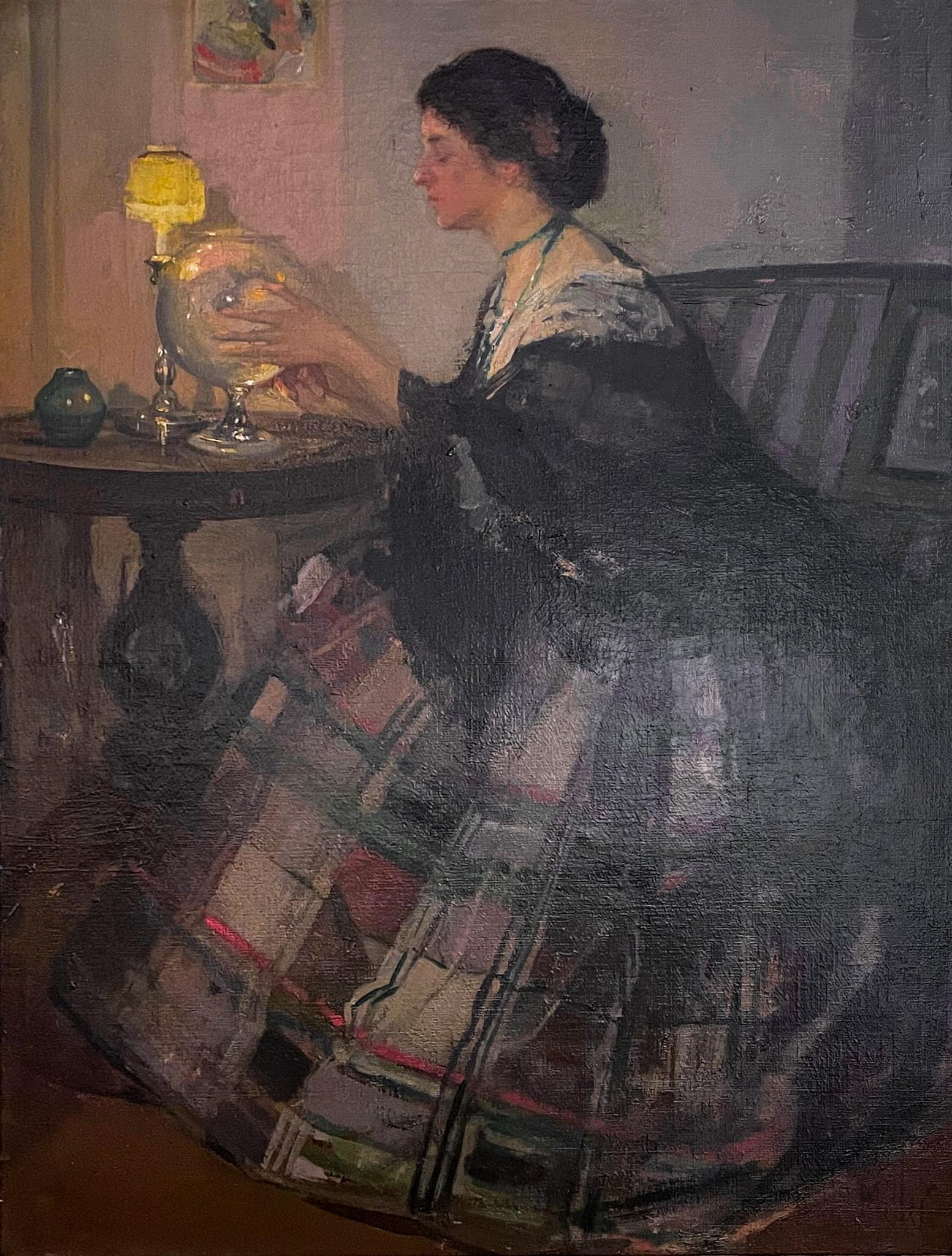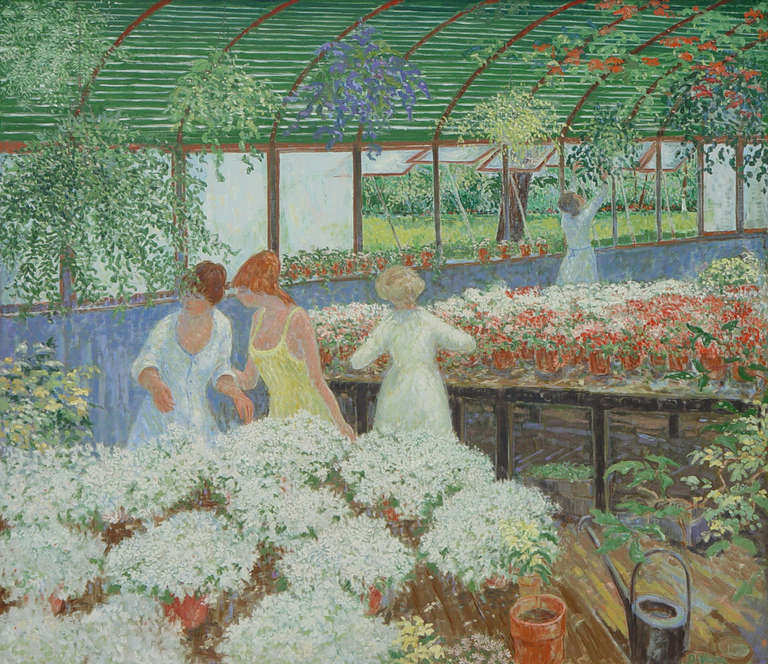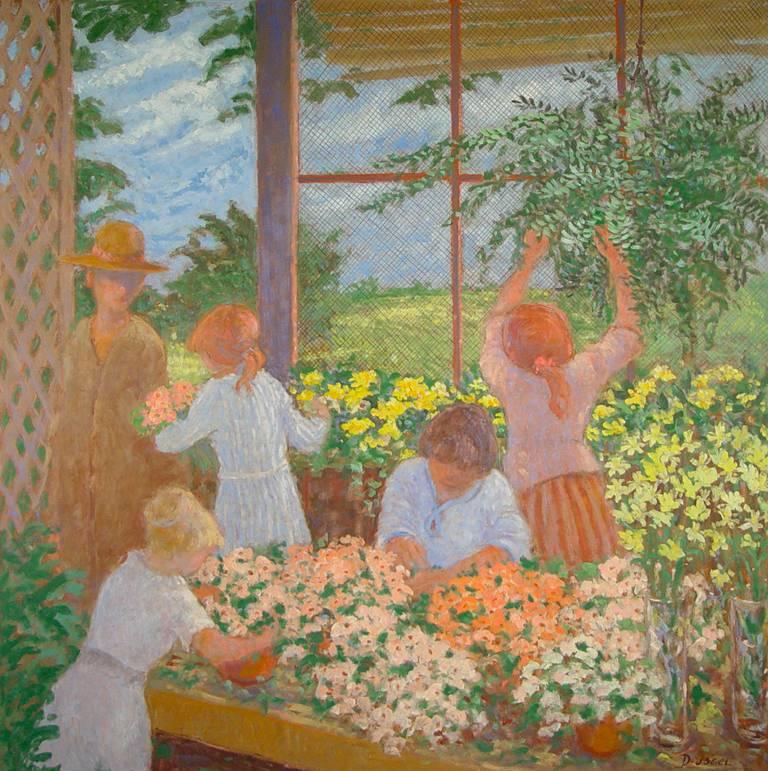Items Similar to Knitting by the Herth
Want more images or videos?
Request additional images or videos from the seller
1 of 9
Sam UhrdinKnitting by the Herth1955
1955
About the Item
Oil on canvas, signed and dated in the upper left and inscribed on the reverse. Painting features a Swedish girl knitting by the fire. The work has a lovely warm feel to it. Sam Uhrdin (Swedish School, 1886-1964) Sam Uhrdin was born in 1886 in the Swedish town of Siljasnas to the north-west of Stockholm. Uhrdin's talent for drawing was recognized from a young age and he was sent to study painting at the Stockholm Academy of Fine Art. Uhrdin quickly gained a reputation for painting scenes of everyday life rendered in intimate settings bathed in warm and subtle light. Uhrdin's paintings often feature women working delicately and today his work can be seen in the public museum of Leksand in Sweden.
- Creator:Sam Uhrdin (1886 - 1964, Swedish)
- Creation Year:1955
- Dimensions:Height: 33.75 in (85.73 cm)Width: 29.25 in (74.3 cm)Depth: 2 in (5.08 cm)
- Medium:
- Movement & Style:
- Period:
- Condition:In excellent condition and ready to hang.
- Gallery Location:Wiscasett, ME
- Reference Number:1stDibs: LU506310729712
Sam Uhrdin
Sam Uhrdin (Swedish School, 1886-1964) Sam Uhrdin was born in 1886 in the Swedish town of Siljasnas to the north-west of Stockholm. Uhrdin's talent for drawing was recognized from a young age and he was sent to study painting at the Stockholm Academy of Fine Art. Uhrdin quickly gained a reputation for painting scenes of everyday life rendered in intimate settings bathed in warm and subtle light. Uhrdin's paintings often feature women working delicately and today his work can be seen in the public museum of Leksand in Sweden.
About the Seller
5.0
Vetted Seller
These experienced sellers undergo a comprehensive evaluation by our team of in-house experts.
Established in 1999
1stDibs seller since 2016
97 sales on 1stDibs
Typical response time: <1 hour
- ShippingRetrieving quote...Ships From: Wiscasett, ME
- Return PolicyA return for this item may be initiated within 3 days of delivery.
More From This SellerView All
- Preparing the MealBy Sam UhrdinLocated in Wiscasett, METhis oil on canvas is signed and date in the upper left and measures 38" x 45.25" including the frame. Sam Uhrdin (Swedish School, 1886-1964). Sam Uhrdi...Category
1940s Impressionist Figurative Paintings
MaterialsOil
- The Pool PlayersBy Vincent Campanella 1Located in Wiscasett, MEOil on artist board signed and dated lower right featuring pool players playing a point match in the pool hall. Great WPA feel and texture impasto. Most likel...Category
1940s Post-Impressionist Interior Paintings
MaterialsOil
- Feeding the BabyLocated in Wiscasett, MEOil on canvas, signed upper left. Provenance: Sothebys Amsterdam, Private collection London, Private collection Palm Beach. His working period was from about 1894 to 1973, successively in Rotterdam, Heeze (Heeze-Leende), Hilversum and Laren. He was educated at the Craft School for decorative painters and received evening lessons at the Rotterdam Academy under the direction of A. van Maasdijk. He was a member of the Vereeniging Sint Lucas...Category
Early 20th Century Dutch School Interior Paintings
MaterialsOil
- Tea TimeBy Frank BramleyLocated in Wiscasett, MESigned and dated 92 lower left. Oil on canvas. Frank Bramley British, 1857-1915 Frank Bramley is considered one of the most important artists of the Newlyn School, the group of artists who settled in Newlyn, Cornwall during the 1880s and 1890s, drawn by the light, lifestyle and the example of Alexander Stanhope Forbes, and were at the forefront of 'British Impressionism'. He was particularly ‘in the news’ when his painting of a woman reading in a garden made the astonishing price of $590,000 at Sotheby's New York in late May 1996. As the seminal catalogue of the famous Newlyn School exhibition states, Bramley's reputation has rested for some time on Hopeless Dawn, his major RA exhibition of 1888, and which in recent years has been hung almost constantly at the Tate Gallery. Bramley was born in Lincolnshire and trained at Lincoln Art School, later at Verlat's Academy in Antwerp, from where he went to Venice in 1882-83, where our painting was executed. He first showed at the Royal Academy in London in 1884 (both paintings were Venetian scenes), and it was in the winter of 1884/5 that Bramley settled in Newlyn. He was a quiet and reserved figure, prone to bouts of melancholy. He worked on his own in a tiny studio in an old thatched cottage - the cottage consisted of two rooms, one at ground level (which was the studio) and one which was below ground which was inhabited by a woman who'd lost her arms and who managed to look after a set of tiny children as well as a small potato and turnip shop. Bramley moved to a purpose-built glass studio in 1889. He is known as the master of the so-called 'square-brush technique' which characterizes much of the best Newlyn School work and he used this until 1893, later than most of his colleagues. Bramley was friendly with the great artist Sargent and with him was elected an associate of the Royal Academy in 1894, being elected a full member in 1911. In 1891 he had married, and 4 years later they moved to the Midlands where his work became less socially orientated and more purely decorative. His last years were spent in a London flat...Category
1890s Victorian Figurative Paintings
MaterialsOil
- A Mother and Her ChildrenBy Bernard PothastLocated in Wiscasett, METhis is an original unique oil painting by the artist Bernard Pothast, signed in the lower right corner, featuring a mother and her children sitting around the kitchen table. Measu...Category
Early 20th Century Dutch School Figurative Paintings
MaterialsOil
- The BallerinaBy Pierre Carrier-BelleuseLocated in Wiscasett, MEPastel on canvas, signed lower right, measuring 38" x 48.25" including the frame. Pierre Carrier-Belleuse His first studies were with his father, the sculptor Albert-Ernest Carrier-...Category
Early 1900s Impressionist Figurative Paintings
MaterialsPastel
You May Also Like
- The Goldfish BowlBy Richard Edward MillerLocated in New York, NYThe Goldfish Bowl by Richard Miller (1875-1943) Oil on canvas 37 ½ x 29 ¾ inches unframed (95.25 x 75.565 cm) 46 ⅝ x 36 ¼ inches framed (118.428 x 97.155...Category
Early 20th Century American Impressionist Figurative Paintings
MaterialsOil
- Early 20th century French oil, seated ballerina adjusting her ballet slipper.Located in Woodbury, CTVery Impressive French Impressionist figure study of a Ballerina seated in an interior. A very decorative and very desirable oil on canvas dating from the early 1900's The painting...Category
Early 1900s Impressionist Figurative Paintings
MaterialsCanvas, Oil
- Old Men with Kittens - Impressionist Oil, Figures in Interior by J F RaffaelliBy Jean-Francois RaffaelliLocated in Marlow, BuckinghamshireA wonderful oil on panel by French impressionist painter Jean-Francois Raffaelli depicting two old men seated in an interior. One is reading his paper as the other naps and there are several kittens on the floor. Painted in the artist's distinctive style. The work is accompanied by a certificate from Brame & Lorenceau and is included in the catalogue raisonne of the painter. Signature: Signed lower left Dimensions: Framed: 9.5"x8" Unframed: 5.5"x4" Provenance: Private collection - United States Original artists label verso Jean-François Raffaëlli's father was a failed Italian businessman and Raffaëlli himself was, among other things, a church chorister, actor and theatre singer. He then studied under Gérôme at the École des Beaux-Arts in Paris. He travelled to Italy, Spain and Algeria and on his return to France settled in Asnières. In 1876, on a trip to Brittany, he first saw the potential of realist subject matter, if treated seriously. He became involved in meetings of artists at the Café Guerbois, where the Impressionist painters used to gather. As a result, Degas, contrary to the advice of the group, introduced Raffaëlli to the Impressionist exhibitions - according to one uncertain source as early as the very first exhibition, at the home of Nadar, and certainly to those of 1880 and 1881. In 1904, Raffaëlli founded the Society for Original Colour Engraving. He first exhibited at the Salon de Paris in 1870 and continued to exhibit there until he joined the Salon des Artistes Français in 1881, where he earned a commendation in 1885, was made Chevalier of the Légion d'Honneur in 1889 and in the same year was awarded a gold medal at the Exposition Universelle. In 1906 he was made Officier of the Légion d'Honneur. He was also a member of the Société Nationale des Beaux-Arts. In 1884, a private exhibition of his work cemented his reputation. He contributed to several newspapers such as The Black Cat (Le Chat Noir) in 1885 and The French Mail (Le Courrier Français) in 1886 and 1887. He published a collection entitled Parisian Characters, which captured his favourite themes of the street, the neighbourhood and local people going about their lives. In 1880 he participated, with Forain, on the illustration of Joris Karl Huysmans' Parisian Sketches (Croquis Parisiens). He also illustrated Huysman's Works. As well as working as an illustrator, he also made etchings and coloured dry-points. His early attempts at painting were genre scenes, but once he was settled in Asnières he started to paint picturesque views of Parisian suburbs. From 1879 onwards, his subject matter drew on the lives of local people. These popular themes, which he treated with humanity and a social conscience, brought him to the attention of the social realist writers of the time such as Émile Zola. In addition to his realist style, Raffaëlli's dark palette, which ran contrary to the Impressionist aesthethic, helped to explain the opposition of those painters to his participation in their exhibitions. More concerned with drawing than colour, he used black and white for most of his paintings. Towards the end of his life, he lightened his palette, but without adopting any other principles of the Impressionist technique. After painting several portraits, including Edmond de Goncourt and Georges Clémenceau, he returned to genre painting, particularly scenes of bourgeois life. Later in his career, he painted mainly Breton-inspired sailors and views of Venice. His views of the Paris slums and the fortifications, sites which have almost completely disappeared, went some way towards establishing a genre in themselves and perpetuated the memory of the area: The Slums, Rag-and-Bone Man, Vagabond, Sandpit, In St-Denis, Area of Fortifications. His realistic and witty portrayal of typical Parisian townscapes accounts for his enduring appeal. Born in Paris, he was of Tuscan descent through his paternal grandparents. He showed an interest in music and theatre before becoming a painter in 1870. One of his landscape paintings was accepted for exhibition at the Salon in that same year. In October 1871 he began three months of study under Jean-Léon Gérôme at the École des Beaux-Arts in Paris; he had no other formal training. Raffaëlli produced primarily costume pictures until 1876, when he began to depict the people of his time—particularly peasants, workers, and ragpickers seen in the suburbs of Paris—in a realistic style. His new work was championed by influential critics such as J.-K. Huysmans, as well as by Edgar Degas. The ragpicker became for Raffaëlli a symbol of the alienation of the individual in modern society. Art historian Barbara S. Fields has written of Raffaëlli's interest in the positivist philosophy of Hippolyte-Adolphe Taine, which led him to articulate a theory of realism that he christened caractérisme. He hoped to set himself apart from those unthinking, so-called realist artists whose art provided the viewer with only a literal depiction of nature. His careful observation of man in his milieu paralleled the anti-aesthetic, anti-romantic approach of the literary Naturalists, such as Zola and Huysmans. Degas invited Raffaëlli to participate in the Impressionist exhibitions of 1880 and 1881, an action that bitterly divided the group; not only was Raffaëlli not an Impressionist, but he threatened to dominate the 1880 exhibition with his outsized display of 37 works. Monet, resentful of Degas's insistence on expanding the Impressionist exhibitions by including several realists, chose not to exhibit, complaining, "The little chapel has become a commonplace school which opens its doors to the first dauber to come along."An example of Raffaëlli's work from this period is Les buveurs d'absinthe (1881, in the California Palace of Legion of Honor Art Museum in San Francisco). Originally titled Les déclassés, the painting was widely praised at the 1881 exhibit. After winning the Légion d'honneur in 1889, Raffaëlli shifted his attention from the suburbs of Paris to city itself, and the street scenes that resulted were well received by the public and the critics. He made a number of sculptures, but these are known today only through photographs.[2] His work was also part of the painting event in the art competition at the 1912 Summer Olympics. In the later years of his life, he concentrated on color printmaking. Raffaëlli died in Paris on February 11, 1924 Museum and Gallery Holdings: Béziers: Peasants Going to Town Bordeaux: Bohemians at a Café Boston: Notre-Dame; Return from the Market Brussels: Chevet of Notre-Dame; pastel Bucharest (Muz. National de Arta al României): Market at Antibes; Pied-à-terre Copenhagen: Fishermen on the Beach Douai: Return from the Market; Blacksmiths Liège: Absinthe Drinker...Category
1890s Impressionist Figurative Paintings
MaterialsPanel, Oil
- Daumier French Impressionist Museum Interior Women Framed Cool Colors Blue PinkBy Jean DaumierLocated in Buffalo, NYAn original oil on canvas painting by French artist Jean Daumier (b. 1948). This endlessly charming work depicts three young women inside a museum in the artist's signature style, ...Category
1970s Impressionist Figurative Paintings
MaterialsOil, Canvas
- Greenhouse in BloomBy Donald S. VogelLocated in Dallas, TXThe greenhouse became a favorite subject of Donald Vogel's in the 1980's. As Vogel reflected in the 1998 catalogue published for his traveling retrospective exhibition, "The greenhou...Category
1970s American Impressionist Figurative Paintings
MaterialsOil
- Flower ShedBy Donald S. VogelLocated in Dallas, TXThe greenhouse became a favorite subject of Donald Vogel's in the 1980's. As Vogel reflected in the 1998 catalogue published for his traveling retrospective exhibition, "The greenhou...Category
Late 20th Century American Impressionist Figurative Paintings
MaterialsOil, Panel




